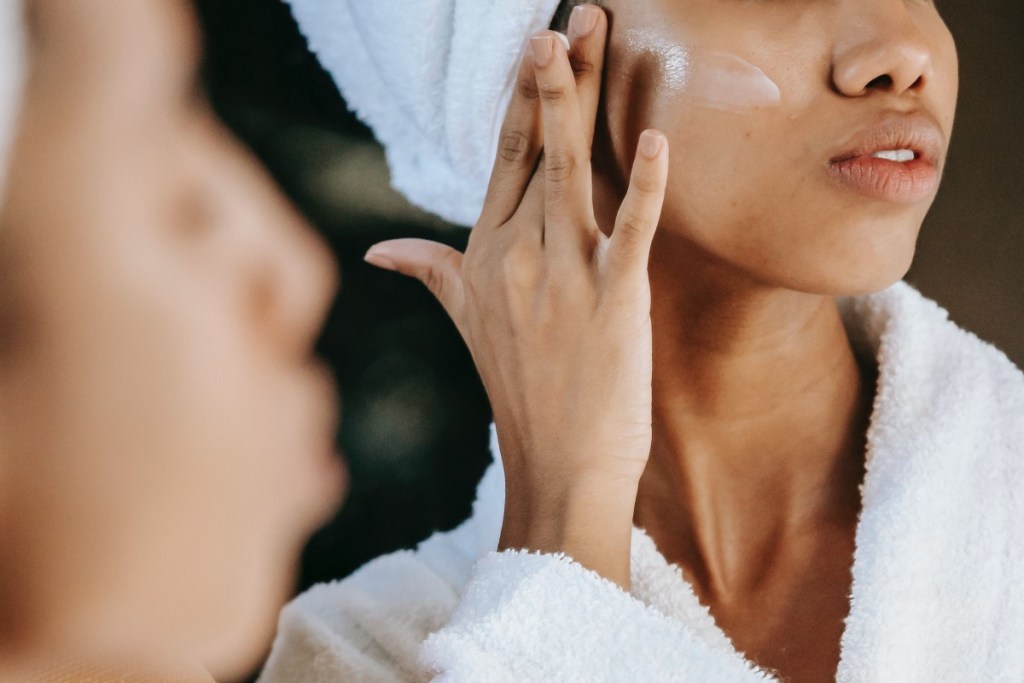Acne is often seen as a problem that goes away after puberty, but it can actually occur at any age. The American Academy of Dermatology Association reports that up to 15 percent of adult women experience acne.
Acne isn’t just a physical appearance problem. It can do a number on your self-esteem and confidence. If you’re experiencing a breakout, you may feel uncomfortable going out. What’s more, it can be painful.
However, there are a few steps you can take to clear up and prevent acne. Here’s how to build the best skincare routine for acne, based on dermatologist recommendations.
Daily skincare routine order
This four-step skincare routine should be done twice per day, ideally in the morning and at night.
Use an acne-busting cleanser
Find an oil-free, non-comedogenic cleanser that doesn’t clog pores and has salicylic acid or benzoyl peroxide. Use your fingers to gently rub the cleanser onto your entire face in a circular motion. Don’t just dab it on your pimples — that won’t help prevent future breakouts. Leave it on for the recommended amount of time. Then, use your fingers and warm water to rinse off the cleanser gently. Pat your face with a clean towel to dry off your skin.
Apply toner or astringent
If you have oily skin, try out a toner or astringent. These products nix excess oil and hydrate your skin. High alcohol content can dry out skin, so check the label to ensure the product you choose has a low amount of this ingredient. Stop using it if it causes irritation.
Apply acne medications
If a dermatologist has prescribed an acne treatment, apply it to a dry face or as directed.
Moisturize
Since acne medications can dry out skin, it’s doubly important to moisturize two times per day (even if you have oily skin). Opt for an oil-free moisturizer.

Long-term skincare advice for people with acne
Though it would be great to zap zits and move on, acne treatment is more of a marathon than a sprint. Here’s a couple of things to keep in mind when it comes to long-term care.
- Wash sheets (and anything that comes into contact with skin) weekly. Things that clog your pores, such as dirt and bacteria, build up on items like sheets, pillowcases, and hats and can make acne worse. For more severe acne, consider swapping out pillowcases two to three times per week.
- Work on stress management. Stress can cause breakouts (and make you even more stressed). Try adding a weekly yoga or meditation session to your schedule.
- Be patient. Once you start using a product, it can take four to six weeks to notice any improvement and two to three months or longer to see significant clearing. Assess progress on a monthly basis or every other month.
- See a dermatologist. Working with a dermatologist can help ensure you get the best-in-class skincare routine advice for you. Dermatologists can also prescribe treatment for more severe acne, such as birth control and retinoids. The frequency of your visits will depend on how severe your acne is and the medications prescribed.
Avoid these acne treatment mistakes
If you have acne, it’s tempting to want to try every product in the book at once and to wash your face constantly. However, you may be making your condition worse. Here’s what not to do if you have acne:
- Wash your face constantly. Though it’s understandable that you want to get rid of your acne ASAP, washing your face too often can actually irritate skin and cause more pimples. Wash it when you wake up, before bed, and if you’re sweating.
- Scrub your skin. Easy does it with your skin. Scrubbing it, even if it feels grimy, is also an easy way to exacerbate acne.
- Touch or pop zits. It’s hard to ignore pimples. However, touching them will only add oil, grease, and dirt to your skin that will, in turn, clog pores — hands off the pimples.
Acne is no fun, and it doesn’t have an age limit, unfortunately. Three in 20 women experience acne as adults. That may not seem like many people. However, if you’re one of those three women, you may feel self-conscious during a breakout. That’s understandable. The good news is there are remedies that will help you clear up your skin and mitigate acne in the future.
Figuring out how to build the best skincare routine for acne can be difficult, and a dermatologist can help. That said, simple tweaks, like washing sheets weekly, can go a long way. Also, remember: Sometimes, less is more. Stick to washing your face twice per day and after sweating. Anything more can worsen acne. When you do wash your face, use an anti-acne cleanser and consider an astringent or toner. Since acne treatments can dry out skin, be sure to moisturize.
BlissMark provides information regarding health, wellness, and beauty. The information within this article is not intended to be medical advice. Before starting any diet or exercise routine, consult your physician. If you don’t have a primary care physician, the United States Health & Human Services department has a free online tool that can help you locate a clinic in your area. We are not medical professionals, have not verified or vetted any programs, and in no way intend our content to be anything more than informative and inspiring.




